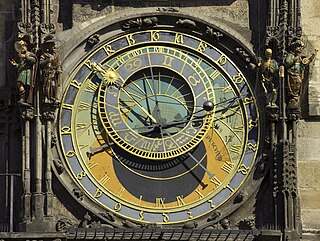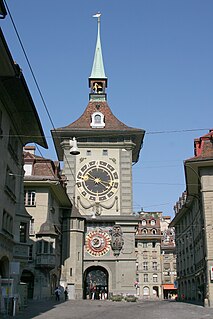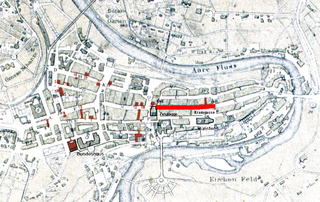
Bern or Berne is the de facto capital of Switzerland, referred to as the "federal city". With a population of about 133,000, Bern is the fifth-most populous city in Switzerland, behind Zurich, Geneva, Basel and Lausanne. The Bern agglomeration, which includes 36 municipalities, had a population of 406,900 in 2014. The metropolitan area had a population of 660,000 in 2000.

An automaton is a relatively self-operating machine, or control mechanism designed to automatically follow a sequence of operations, or respond to predetermined instructions. Some automata, such as bellstrikers in mechanical clocks, are designed to give the illusion to the casual observer that they are operating under their own power. Since long ago, the term is commonly associated with automated puppets that resemble moving humans or animals, built to impress and/or to entertain people.

Clock towers are a specific type of structure which house a turret clock and have one or more clock faces on the upper exterior walls. Many clock towers are freestanding structures but they can also adjoin or be located on top of another building. Some other buildings also have clock faces on their exterior but these structures serve other main functions.

An astronomical clock, horologium, or orloj is a clock with special mechanisms and dials to display astronomical information, such as the relative positions of the Sun, Moon, zodiacal constellations, and sometimes major planets.

The Zytglogge is a landmark medieval tower in Bern, Switzerland. Built in the early 13th century, it has served the city as guard tower, prison, clock tower, centre of urban life and civic memorial.

Otto Brunfels was a German theologian and botanist. Carl von Linné listed him among the "Fathers of Botany".

The Christoffelturm was a tower built between the years 1344 and 1346, which featured a prominently displayed statue of Saint Christopher. It was located in the old part of the Swiss city of Bern, in the upper section of Spitalgasse, near Holy Spirit Church.

The Old City is the medieval city center of Bern, Switzerland. Built on a narrow hill bordered on three sides by the river Aare, its compact layout has remained essentially unchanged since its construction during the twelfth to the fifteenth century. Despite a major fire in 1405, after which much of the city was rebuilt in sandstone, and substantial construction efforts in the eighteenth century, Bern's old city has retained its medieval character.

The Kramgasse is one of the principal streets in the Old City of Bern, the medieval city centre of Bern, Switzerland. It was the center of urban life in Bern until the 19th century. Today, it is a popular shopping street. Its length, slight curve and long line of Baroque façades combine to produce Bern's most impressive streetscape.

The Gerechtigkeitsgasse is one of the principal streets in the Old City of Bern, the medieval city center of Bern, Switzerland. Together with its extension, the Kramgasse, it is the heart of the inner city. Hans Gieng's most famous fountain figure, the statue of Lady Justice on the Gerechtigkeitsbrunnen, commands the view of the street's gentle slopes and curves.

A jacquemart is an automaton, an animated, mechanised figure of a person, usually made from wood or metal, which strikes the hours on a bell with a hammer. Jacquemarts are usually part of clocks or clocktowers, and are often near or at the top of the construction. The figurine is also known as Jack of the Clock or Jack o'Clock.

The Marktgasse is one of the streets in the Old City of Bern, the medieval city center of Bern, Switzerland. It is part of the Innere Neustadt which was built during the 13th Century. It runs from the Käfigturm between Waisenhausplatz and Bärenplatz in the west to the Zytglogge between Kornhausplatz and Theaterplatz in the east. It is part of the UNESCO Cultural World Heritage Site that encompasses the Old City.

The Zähringerstadt is a historic section in the Old City of Bern in Bern, Switzerland.

The Reformed Nydeggkirche is located on the eastern edge of the Old City of Bern, in the Nydegg section.

The Käfigturm is a Baroque tower in Bern, Switzerland. It is part of the UNESCO Cultural World Heritage Site of the Old City of Bern and the tower is a Cultural Property of National Significance. The original tower was built as a gate house during the second expansion of Bern in 1256. The tower was demolished in 1640 and completely rebuilt immediately thereafter.
A gate tower is a tower built over or next to a major gateway.

The roundel is an artillery fortification with a rounded or circular plan of a similar height to the adjacent defensive walls. If the fortification is clearly higher than the walls it is called a battery tower.
The following is a timeline of the history of the municipality of Bern, Switzerland.
Kaspar is a given name and surname which may refer to:

















